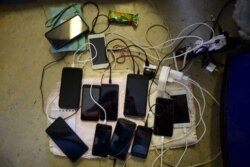Puerto Rico slowly began to recover Wednesday from the string of devastating earthquakes that have hit the U.S. Caribbean island territory since late December.
Its power grid, intentionally shut down as a safety measure after Tuesday's 6.4-magnitude earthquake, was partially brought back to life. Nearly 500,000 of the island's 1.5 million customers had service again, up from 100,000 on Tuesday night.
Gov. Wanda Vasquez said that most of Puerto Rico should have power restored by Thursday, provided there are no more earthquakes.
Meantime, hundreds of families are sleeping in their cars, and on cots and chairs outdoors, for fear that their homes might collapse in aftershocks or new temblors. More than 250,000 Puerto Ricans remain without water.
U.S. President Donald Trump, who often criticized island officials for their handling of recovery efforts after past hurricanes, declared a state of emergency after Tuesday's powerful quake.
The declaration authorizes the Federal Emergency Management Agency to coordinate disaster relief, with the national government picking up 75% of the cost of recovery.
Tuesday's earthquake was located near the southern coastal city of Ponce, according to the U.S. Geological Survey. A number of powerful aftershocks followed the quake, including one measuring 6.0.
The Pacific Tsunami Warning Center issued an alert immediately after the quake was reported, but it was later canceled.
The Puerto Rico Electric Power Authority says power was shut off across the the entire island after automatic protection systems at all of its power plants were activated.
A 77-year-old Ponce man was killed in Tuesday's quake when a wall in his home fell on him.
The quakes caused heavy damage in some areas. A Ponce official said many buildings were damaged. In the southern coastal town of Guayanilla, the church in the public plaza collapsed, the mayor said in an interview on a local radio station.
The island has been shaken by numerous quakes of varying degrees since Dec. 28. A 5.8-magnitude quake on Monday leveled several homes in the southern coastal town of Guanica and destroyed a coastal rock formation known as Punta Ventana in nearby Guayanilla. The formation, shaped like a round stone window, was a popular tourist attraction.









